University Negotiation Role Play and Summary Report
VerifiedAdded on 2022/09/28
|10
|2288
|63
Report
AI Summary
This report analyzes a negotiation scenario involving the sale of a commercial property. The student identifies their preferred anarchic thinking style and external scope, explaining their suitability for the negotiation. The report details the client's BATNA (Best Alternative to a Negotiated Agreement) and reservation value, as well as the other party's. It calculates the Zone of Possible Agreement (ZOPA) and outlines a strategy for claiming a greater proportion of it. The report includes a transcript of the negotiation conversation, highlighting key offers and counteroffers. The student reflects on their approach, suggesting adjustments to optimize their thinking style. The report concludes by summarizing the final negotiation outcome and the rationale behind it, emphasizing the importance of understanding the client's needs, the property's valuation, and the other party's alternatives to achieve a successful outcome.
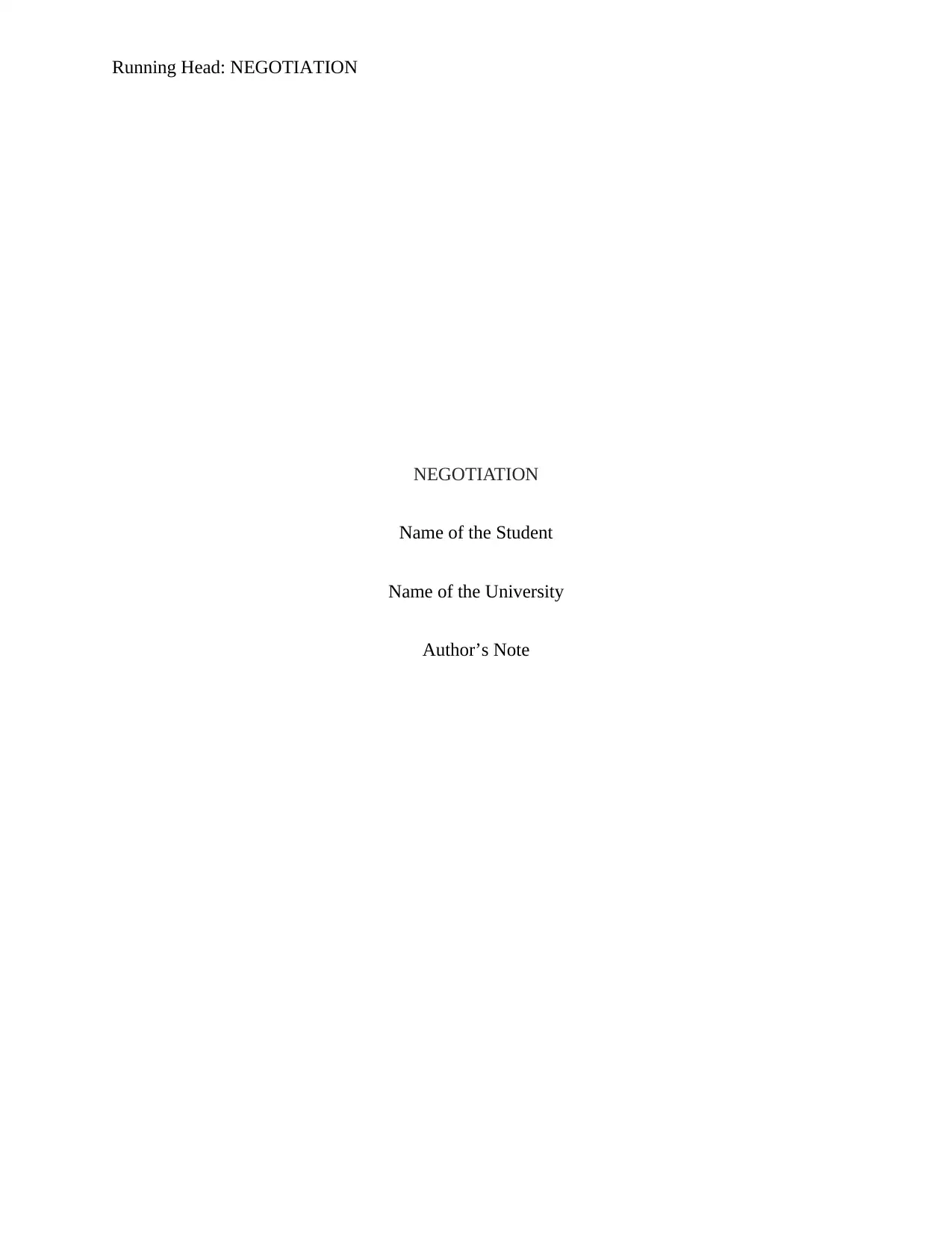
Running Head: NEGOTIATION
NEGOTIATION
Name of the Student
Name of the University
Author’s Note
NEGOTIATION
Name of the Student
Name of the University
Author’s Note
Paraphrase This Document
Need a fresh take? Get an instant paraphrase of this document with our AI Paraphraser
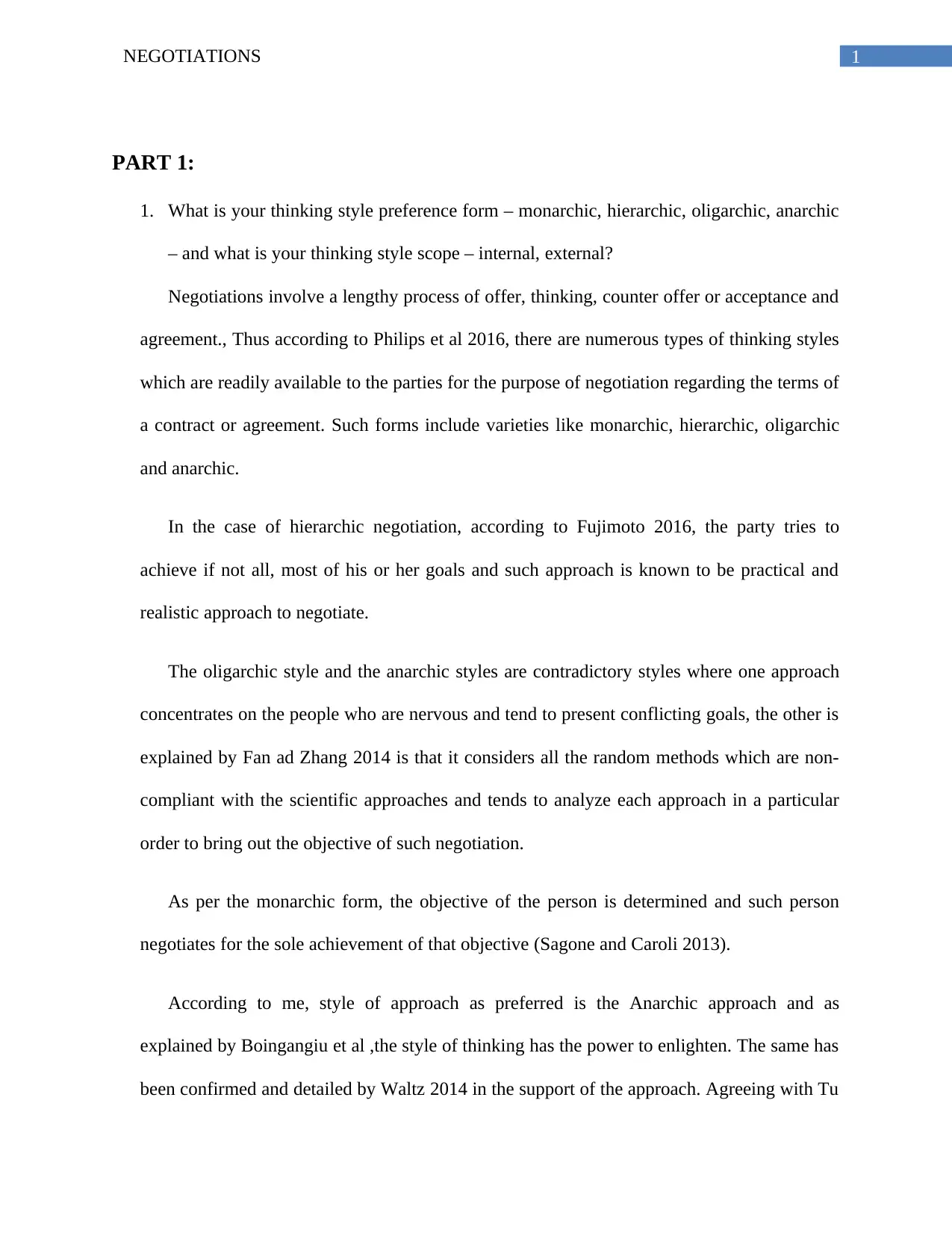
1NEGOTIATIONS
PART 1:
1. What is your thinking style preference form – monarchic, hierarchic, oligarchic, anarchic
– and what is your thinking style scope – internal, external?
Negotiations involve a lengthy process of offer, thinking, counter offer or acceptance and
agreement., Thus according to Philips et al 2016, there are numerous types of thinking styles
which are readily available to the parties for the purpose of negotiation regarding the terms of
a contract or agreement. Such forms include varieties like monarchic, hierarchic, oligarchic
and anarchic.
In the case of hierarchic negotiation, according to Fujimoto 2016, the party tries to
achieve if not all, most of his or her goals and such approach is known to be practical and
realistic approach to negotiate.
The oligarchic style and the anarchic styles are contradictory styles where one approach
concentrates on the people who are nervous and tend to present conflicting goals, the other is
explained by Fan ad Zhang 2014 is that it considers all the random methods which are non-
compliant with the scientific approaches and tends to analyze each approach in a particular
order to bring out the objective of such negotiation.
As per the monarchic form, the objective of the person is determined and such person
negotiates for the sole achievement of that objective (Sagone and Caroli 2013).
According to me, style of approach as preferred is the Anarchic approach and as
explained by Boingangiu et al ,the style of thinking has the power to enlighten. The same has
been confirmed and detailed by Waltz 2014 in the support of the approach. Agreeing with Tu
PART 1:
1. What is your thinking style preference form – monarchic, hierarchic, oligarchic, anarchic
– and what is your thinking style scope – internal, external?
Negotiations involve a lengthy process of offer, thinking, counter offer or acceptance and
agreement., Thus according to Philips et al 2016, there are numerous types of thinking styles
which are readily available to the parties for the purpose of negotiation regarding the terms of
a contract or agreement. Such forms include varieties like monarchic, hierarchic, oligarchic
and anarchic.
In the case of hierarchic negotiation, according to Fujimoto 2016, the party tries to
achieve if not all, most of his or her goals and such approach is known to be practical and
realistic approach to negotiate.
The oligarchic style and the anarchic styles are contradictory styles where one approach
concentrates on the people who are nervous and tend to present conflicting goals, the other is
explained by Fan ad Zhang 2014 is that it considers all the random methods which are non-
compliant with the scientific approaches and tends to analyze each approach in a particular
order to bring out the objective of such negotiation.
As per the monarchic form, the objective of the person is determined and such person
negotiates for the sole achievement of that objective (Sagone and Caroli 2013).
According to me, style of approach as preferred is the Anarchic approach and as
explained by Boingangiu et al ,the style of thinking has the power to enlighten. The same has
been confirmed and detailed by Waltz 2014 in the support of the approach. Agreeing with Tu
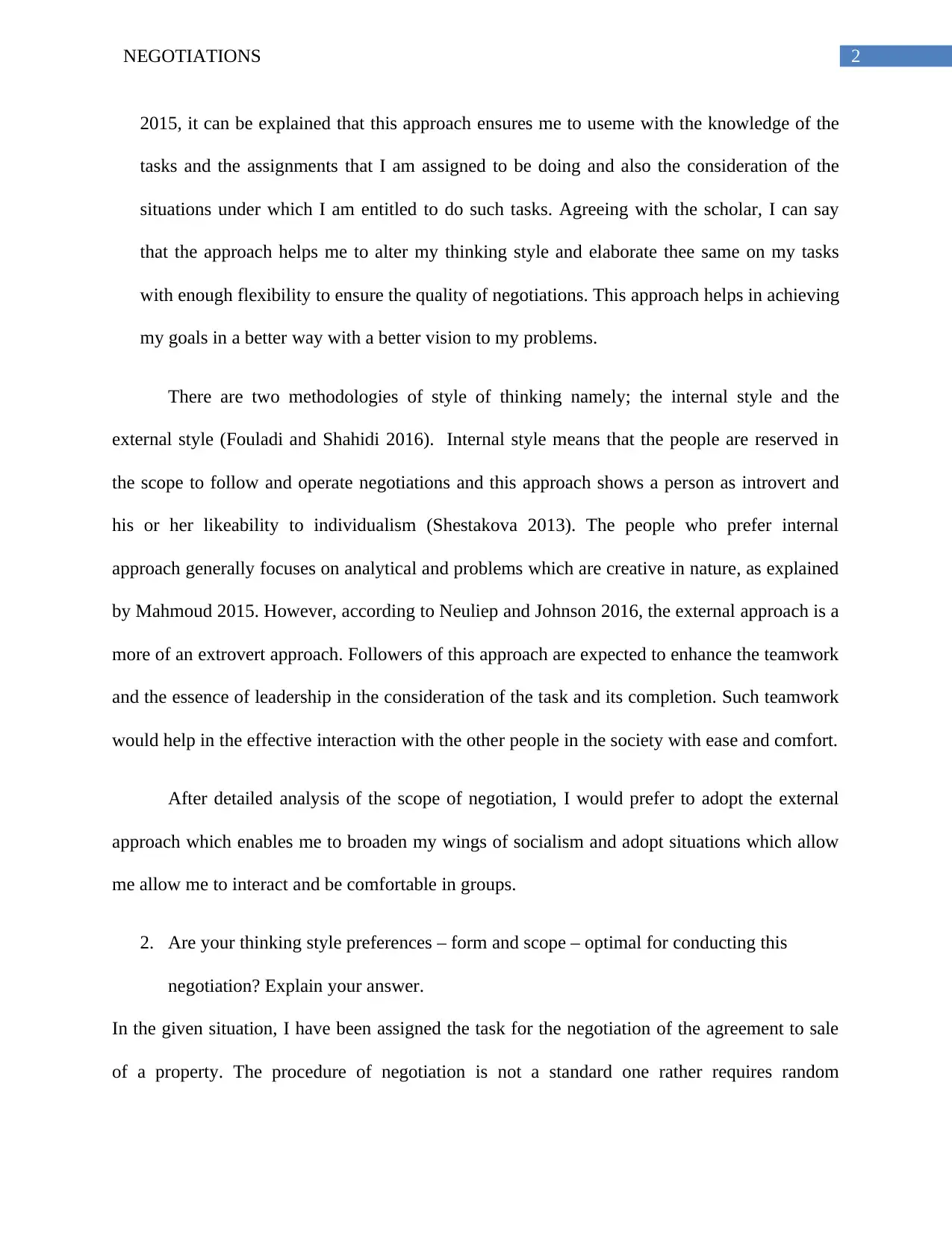
2NEGOTIATIONS
2015, it can be explained that this approach ensures me to useme with the knowledge of the
tasks and the assignments that I am assigned to be doing and also the consideration of the
situations under which I am entitled to do such tasks. Agreeing with the scholar, I can say
that the approach helps me to alter my thinking style and elaborate thee same on my tasks
with enough flexibility to ensure the quality of negotiations. This approach helps in achieving
my goals in a better way with a better vision to my problems.
There are two methodologies of style of thinking namely; the internal style and the
external style (Fouladi and Shahidi 2016). Internal style means that the people are reserved in
the scope to follow and operate negotiations and this approach shows a person as introvert and
his or her likeability to individualism (Shestakova 2013). The people who prefer internal
approach generally focuses on analytical and problems which are creative in nature, as explained
by Mahmoud 2015. However, according to Neuliep and Johnson 2016, the external approach is a
more of an extrovert approach. Followers of this approach are expected to enhance the teamwork
and the essence of leadership in the consideration of the task and its completion. Such teamwork
would help in the effective interaction with the other people in the society with ease and comfort.
After detailed analysis of the scope of negotiation, I would prefer to adopt the external
approach which enables me to broaden my wings of socialism and adopt situations which allow
me allow me to interact and be comfortable in groups.
2. Are your thinking style preferences – form and scope – optimal for conducting this
negotiation? Explain your answer.
In the given situation, I have been assigned the task for the negotiation of the agreement to sale
of a property. The procedure of negotiation is not a standard one rather requires random
2015, it can be explained that this approach ensures me to useme with the knowledge of the
tasks and the assignments that I am assigned to be doing and also the consideration of the
situations under which I am entitled to do such tasks. Agreeing with the scholar, I can say
that the approach helps me to alter my thinking style and elaborate thee same on my tasks
with enough flexibility to ensure the quality of negotiations. This approach helps in achieving
my goals in a better way with a better vision to my problems.
There are two methodologies of style of thinking namely; the internal style and the
external style (Fouladi and Shahidi 2016). Internal style means that the people are reserved in
the scope to follow and operate negotiations and this approach shows a person as introvert and
his or her likeability to individualism (Shestakova 2013). The people who prefer internal
approach generally focuses on analytical and problems which are creative in nature, as explained
by Mahmoud 2015. However, according to Neuliep and Johnson 2016, the external approach is a
more of an extrovert approach. Followers of this approach are expected to enhance the teamwork
and the essence of leadership in the consideration of the task and its completion. Such teamwork
would help in the effective interaction with the other people in the society with ease and comfort.
After detailed analysis of the scope of negotiation, I would prefer to adopt the external
approach which enables me to broaden my wings of socialism and adopt situations which allow
me allow me to interact and be comfortable in groups.
2. Are your thinking style preferences – form and scope – optimal for conducting this
negotiation? Explain your answer.
In the given situation, I have been assigned the task for the negotiation of the agreement to sale
of a property. The procedure of negotiation is not a standard one rather requires random
⊘ This is a preview!⊘
Do you want full access?
Subscribe today to unlock all pages.

Trusted by 1+ million students worldwide
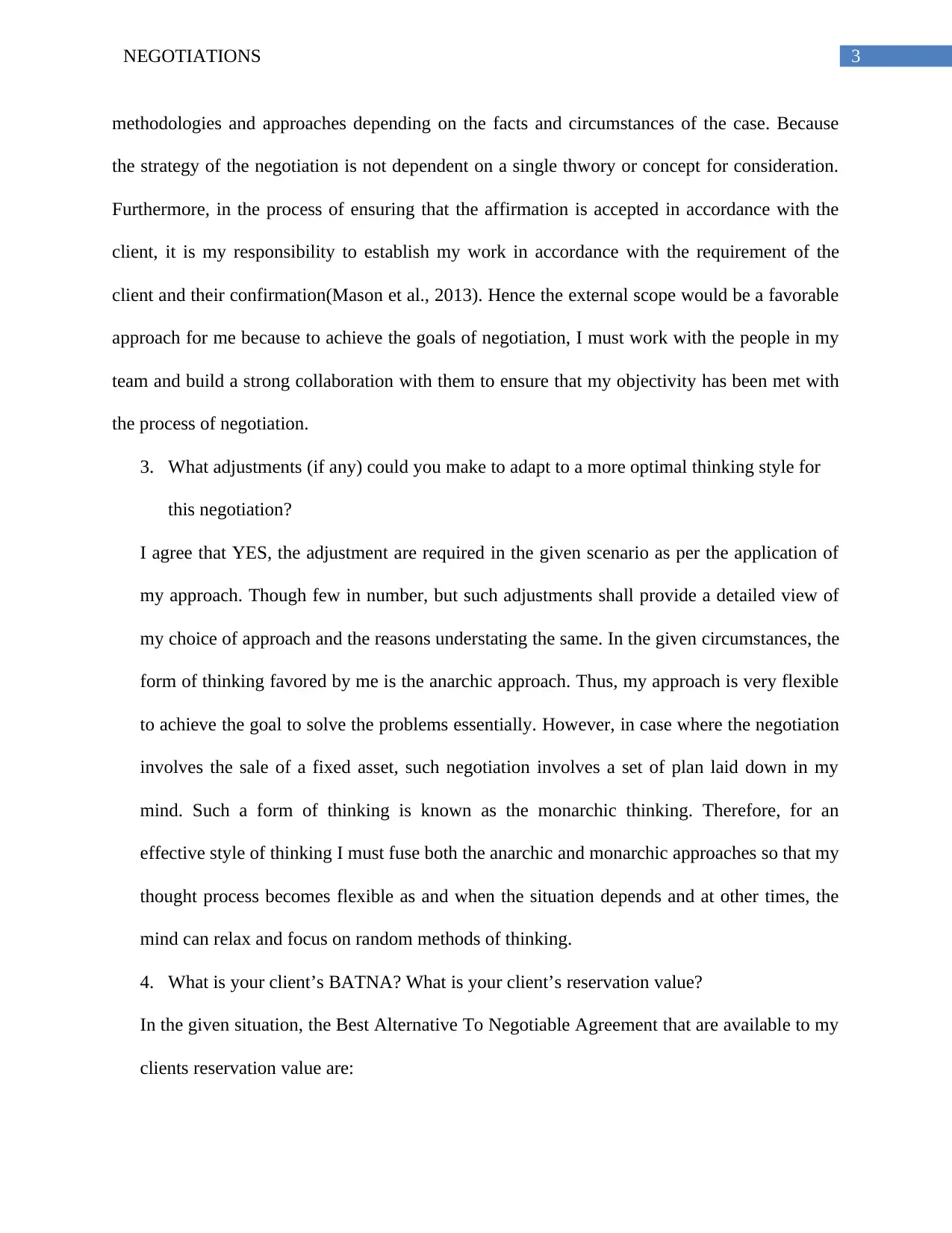
3NEGOTIATIONS
methodologies and approaches depending on the facts and circumstances of the case. Because
the strategy of the negotiation is not dependent on a single thwory or concept for consideration.
Furthermore, in the process of ensuring that the affirmation is accepted in accordance with the
client, it is my responsibility to establish my work in accordance with the requirement of the
client and their confirmation(Mason et al., 2013). Hence the external scope would be a favorable
approach for me because to achieve the goals of negotiation, I must work with the people in my
team and build a strong collaboration with them to ensure that my objectivity has been met with
the process of negotiation.
3. What adjustments (if any) could you make to adapt to a more optimal thinking style for
this negotiation?
I agree that YES, the adjustment are required in the given scenario as per the application of
my approach. Though few in number, but such adjustments shall provide a detailed view of
my choice of approach and the reasons understating the same. In the given circumstances, the
form of thinking favored by me is the anarchic approach. Thus, my approach is very flexible
to achieve the goal to solve the problems essentially. However, in case where the negotiation
involves the sale of a fixed asset, such negotiation involves a set of plan laid down in my
mind. Such a form of thinking is known as the monarchic thinking. Therefore, for an
effective style of thinking I must fuse both the anarchic and monarchic approaches so that my
thought process becomes flexible as and when the situation depends and at other times, the
mind can relax and focus on random methods of thinking.
4. What is your client’s BATNA? What is your client’s reservation value?
In the given situation, the Best Alternative To Negotiable Agreement that are available to my
clients reservation value are:
methodologies and approaches depending on the facts and circumstances of the case. Because
the strategy of the negotiation is not dependent on a single thwory or concept for consideration.
Furthermore, in the process of ensuring that the affirmation is accepted in accordance with the
client, it is my responsibility to establish my work in accordance with the requirement of the
client and their confirmation(Mason et al., 2013). Hence the external scope would be a favorable
approach for me because to achieve the goals of negotiation, I must work with the people in my
team and build a strong collaboration with them to ensure that my objectivity has been met with
the process of negotiation.
3. What adjustments (if any) could you make to adapt to a more optimal thinking style for
this negotiation?
I agree that YES, the adjustment are required in the given scenario as per the application of
my approach. Though few in number, but such adjustments shall provide a detailed view of
my choice of approach and the reasons understating the same. In the given circumstances, the
form of thinking favored by me is the anarchic approach. Thus, my approach is very flexible
to achieve the goal to solve the problems essentially. However, in case where the negotiation
involves the sale of a fixed asset, such negotiation involves a set of plan laid down in my
mind. Such a form of thinking is known as the monarchic thinking. Therefore, for an
effective style of thinking I must fuse both the anarchic and monarchic approaches so that my
thought process becomes flexible as and when the situation depends and at other times, the
mind can relax and focus on random methods of thinking.
4. What is your client’s BATNA? What is your client’s reservation value?
In the given situation, the Best Alternative To Negotiable Agreement that are available to my
clients reservation value are:
Paraphrase This Document
Need a fresh take? Get an instant paraphrase of this document with our AI Paraphraser
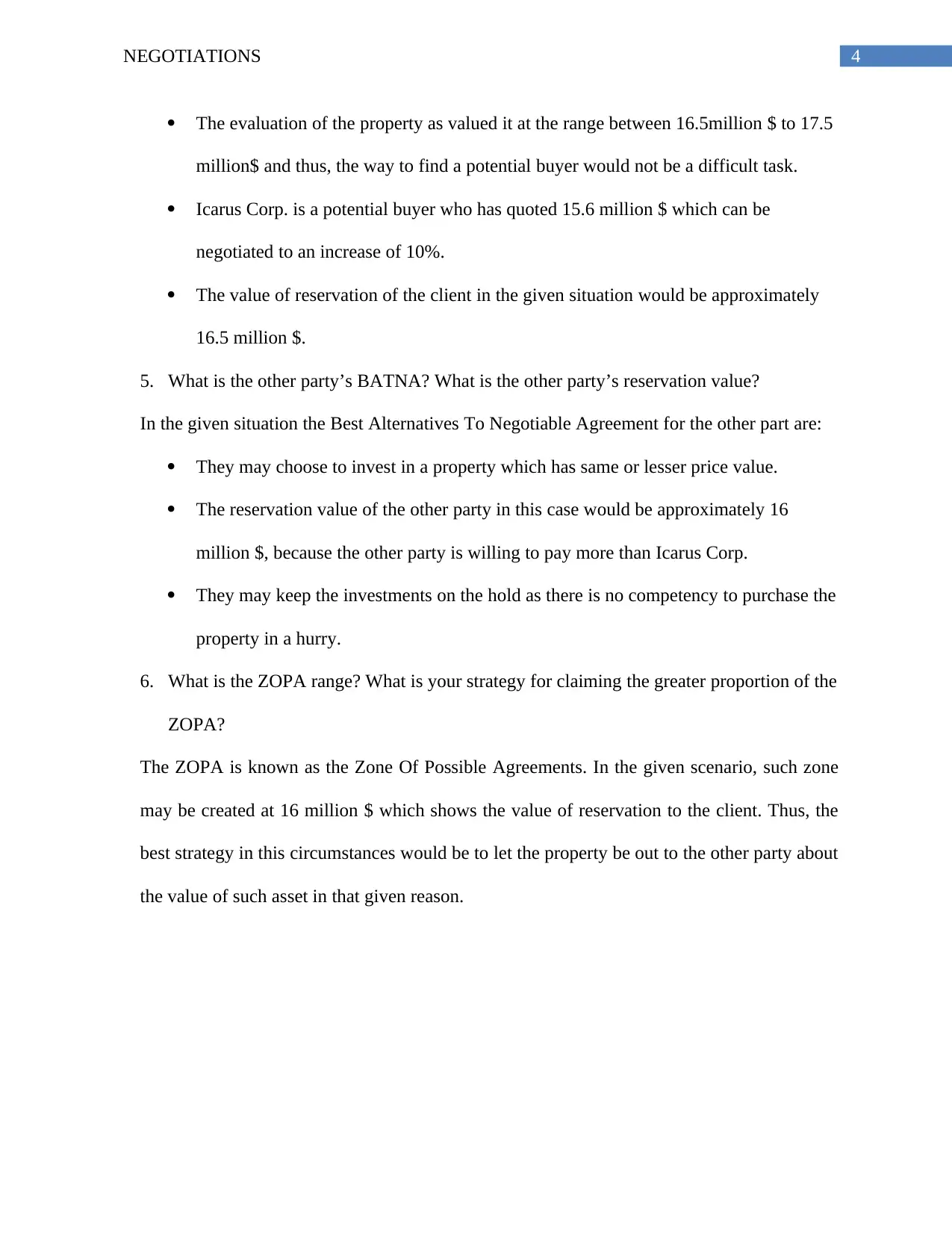
4NEGOTIATIONS
The evaluation of the property as valued it at the range between 16.5million $ to 17.5
million$ and thus, the way to find a potential buyer would not be a difficult task.
Icarus Corp. is a potential buyer who has quoted 15.6 million $ which can be
negotiated to an increase of 10%.
The value of reservation of the client in the given situation would be approximately
16.5 million $.
5. What is the other party’s BATNA? What is the other party’s reservation value?
In the given situation the Best Alternatives To Negotiable Agreement for the other part are:
They may choose to invest in a property which has same or lesser price value.
The reservation value of the other party in this case would be approximately 16
million $, because the other party is willing to pay more than Icarus Corp.
They may keep the investments on the hold as there is no competency to purchase the
property in a hurry.
6. What is the ZOPA range? What is your strategy for claiming the greater proportion of the
ZOPA?
The ZOPA is known as the Zone Of Possible Agreements. In the given scenario, such zone
may be created at 16 million $ which shows the value of reservation to the client. Thus, the
best strategy in this circumstances would be to let the property be out to the other party about
the value of such asset in that given reason.
The evaluation of the property as valued it at the range between 16.5million $ to 17.5
million$ and thus, the way to find a potential buyer would not be a difficult task.
Icarus Corp. is a potential buyer who has quoted 15.6 million $ which can be
negotiated to an increase of 10%.
The value of reservation of the client in the given situation would be approximately
16.5 million $.
5. What is the other party’s BATNA? What is the other party’s reservation value?
In the given situation the Best Alternatives To Negotiable Agreement for the other part are:
They may choose to invest in a property which has same or lesser price value.
The reservation value of the other party in this case would be approximately 16
million $, because the other party is willing to pay more than Icarus Corp.
They may keep the investments on the hold as there is no competency to purchase the
property in a hurry.
6. What is the ZOPA range? What is your strategy for claiming the greater proportion of the
ZOPA?
The ZOPA is known as the Zone Of Possible Agreements. In the given scenario, such zone
may be created at 16 million $ which shows the value of reservation to the client. Thus, the
best strategy in this circumstances would be to let the property be out to the other party about
the value of such asset in that given reason.
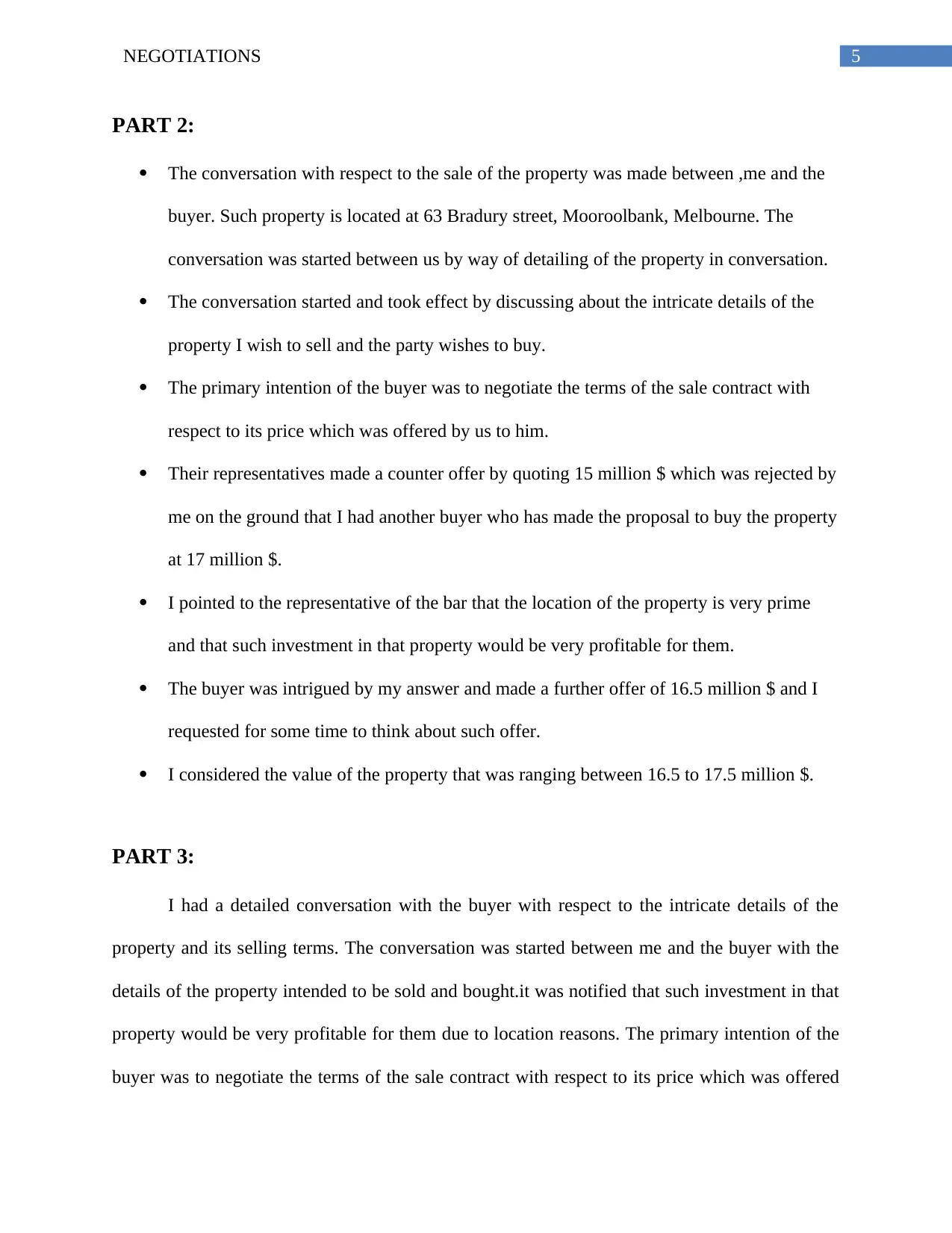
5NEGOTIATIONS
PART 2:
The conversation with respect to the sale of the property was made between ,me and the
buyer. Such property is located at 63 Bradury street, Mooroolbank, Melbourne. The
conversation was started between us by way of detailing of the property in conversation.
The conversation started and took effect by discussing about the intricate details of the
property I wish to sell and the party wishes to buy.
The primary intention of the buyer was to negotiate the terms of the sale contract with
respect to its price which was offered by us to him.
Their representatives made a counter offer by quoting 15 million $ which was rejected by
me on the ground that I had another buyer who has made the proposal to buy the property
at 17 million $.
I pointed to the representative of the bar that the location of the property is very prime
and that such investment in that property would be very profitable for them.
The buyer was intrigued by my answer and made a further offer of 16.5 million $ and I
requested for some time to think about such offer.
I considered the value of the property that was ranging between 16.5 to 17.5 million $.
PART 3:
I had a detailed conversation with the buyer with respect to the intricate details of the
property and its selling terms. The conversation was started between me and the buyer with the
details of the property intended to be sold and bought.it was notified that such investment in that
property would be very profitable for them due to location reasons. The primary intention of the
buyer was to negotiate the terms of the sale contract with respect to its price which was offered
PART 2:
The conversation with respect to the sale of the property was made between ,me and the
buyer. Such property is located at 63 Bradury street, Mooroolbank, Melbourne. The
conversation was started between us by way of detailing of the property in conversation.
The conversation started and took effect by discussing about the intricate details of the
property I wish to sell and the party wishes to buy.
The primary intention of the buyer was to negotiate the terms of the sale contract with
respect to its price which was offered by us to him.
Their representatives made a counter offer by quoting 15 million $ which was rejected by
me on the ground that I had another buyer who has made the proposal to buy the property
at 17 million $.
I pointed to the representative of the bar that the location of the property is very prime
and that such investment in that property would be very profitable for them.
The buyer was intrigued by my answer and made a further offer of 16.5 million $ and I
requested for some time to think about such offer.
I considered the value of the property that was ranging between 16.5 to 17.5 million $.
PART 3:
I had a detailed conversation with the buyer with respect to the intricate details of the
property and its selling terms. The conversation was started between me and the buyer with the
details of the property intended to be sold and bought.it was notified that such investment in that
property would be very profitable for them due to location reasons. The primary intention of the
buyer was to negotiate the terms of the sale contract with respect to its price which was offered
⊘ This is a preview!⊘
Do you want full access?
Subscribe today to unlock all pages.

Trusted by 1+ million students worldwide
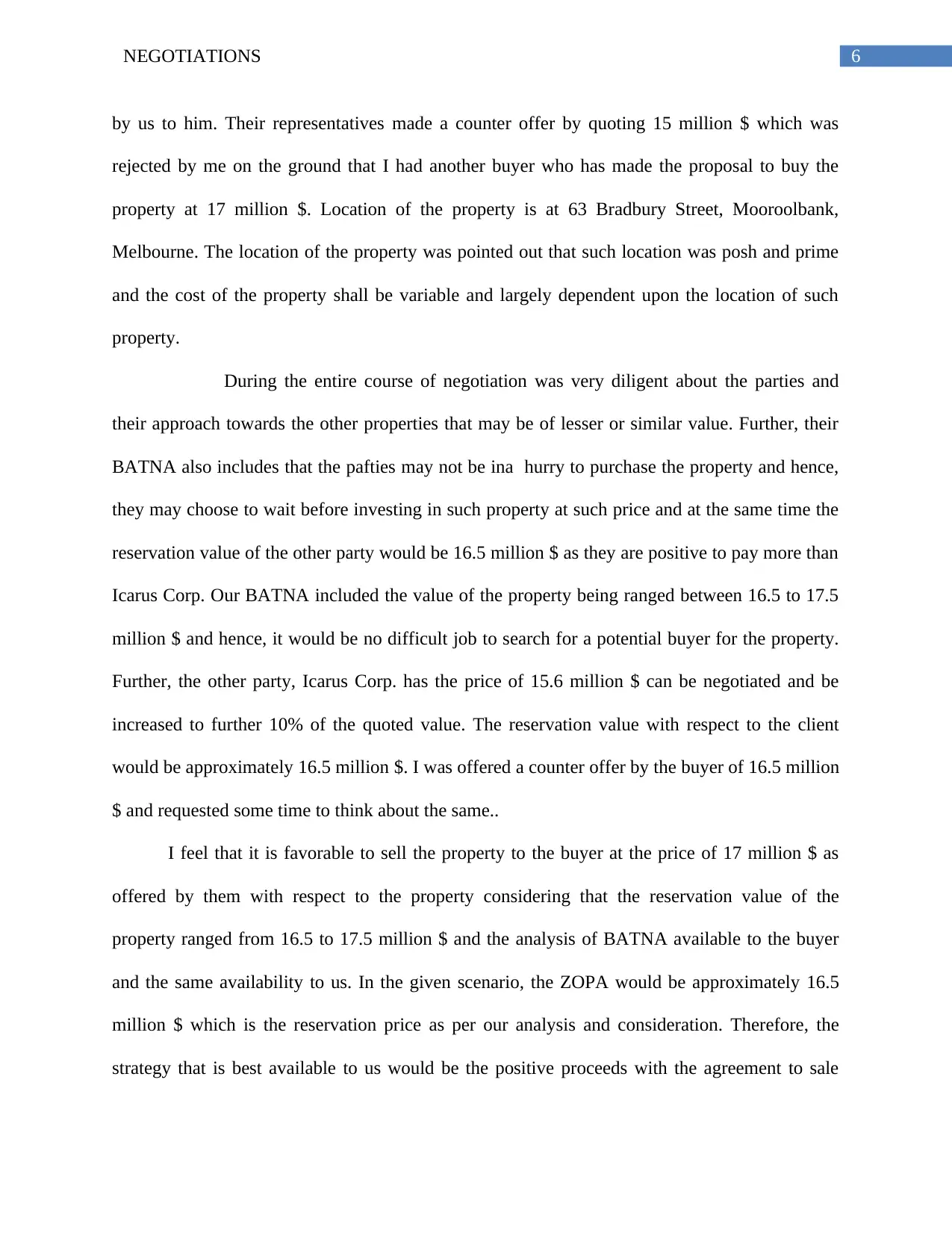
6NEGOTIATIONS
by us to him. Their representatives made a counter offer by quoting 15 million $ which was
rejected by me on the ground that I had another buyer who has made the proposal to buy the
property at 17 million $. Location of the property is at 63 Bradbury Street, Mooroolbank,
Melbourne. The location of the property was pointed out that such location was posh and prime
and the cost of the property shall be variable and largely dependent upon the location of such
property.
During the entire course of negotiation was very diligent about the parties and
their approach towards the other properties that may be of lesser or similar value. Further, their
BATNA also includes that the pafties may not be ina hurry to purchase the property and hence,
they may choose to wait before investing in such property at such price and at the same time the
reservation value of the other party would be 16.5 million $ as they are positive to pay more than
Icarus Corp. Our BATNA included the value of the property being ranged between 16.5 to 17.5
million $ and hence, it would be no difficult job to search for a potential buyer for the property.
Further, the other party, Icarus Corp. has the price of 15.6 million $ can be negotiated and be
increased to further 10% of the quoted value. The reservation value with respect to the client
would be approximately 16.5 million $. I was offered a counter offer by the buyer of 16.5 million
$ and requested some time to think about the same..
I feel that it is favorable to sell the property to the buyer at the price of 17 million $ as
offered by them with respect to the property considering that the reservation value of the
property ranged from 16.5 to 17.5 million $ and the analysis of BATNA available to the buyer
and the same availability to us. In the given scenario, the ZOPA would be approximately 16.5
million $ which is the reservation price as per our analysis and consideration. Therefore, the
strategy that is best available to us would be the positive proceeds with the agreement to sale
by us to him. Their representatives made a counter offer by quoting 15 million $ which was
rejected by me on the ground that I had another buyer who has made the proposal to buy the
property at 17 million $. Location of the property is at 63 Bradbury Street, Mooroolbank,
Melbourne. The location of the property was pointed out that such location was posh and prime
and the cost of the property shall be variable and largely dependent upon the location of such
property.
During the entire course of negotiation was very diligent about the parties and
their approach towards the other properties that may be of lesser or similar value. Further, their
BATNA also includes that the pafties may not be ina hurry to purchase the property and hence,
they may choose to wait before investing in such property at such price and at the same time the
reservation value of the other party would be 16.5 million $ as they are positive to pay more than
Icarus Corp. Our BATNA included the value of the property being ranged between 16.5 to 17.5
million $ and hence, it would be no difficult job to search for a potential buyer for the property.
Further, the other party, Icarus Corp. has the price of 15.6 million $ can be negotiated and be
increased to further 10% of the quoted value. The reservation value with respect to the client
would be approximately 16.5 million $. I was offered a counter offer by the buyer of 16.5 million
$ and requested some time to think about the same..
I feel that it is favorable to sell the property to the buyer at the price of 17 million $ as
offered by them with respect to the property considering that the reservation value of the
property ranged from 16.5 to 17.5 million $ and the analysis of BATNA available to the buyer
and the same availability to us. In the given scenario, the ZOPA would be approximately 16.5
million $ which is the reservation price as per our analysis and consideration. Therefore, the
strategy that is best available to us would be the positive proceeds with the agreement to sale
Paraphrase This Document
Need a fresh take? Get an instant paraphrase of this document with our AI Paraphraser

7NEGOTIATIONS
with the party (as per the reasons best known to them), at the agreed and contracted price of 17
million $.
with the party (as per the reasons best known to them), at the agreed and contracted price of 17
million $.
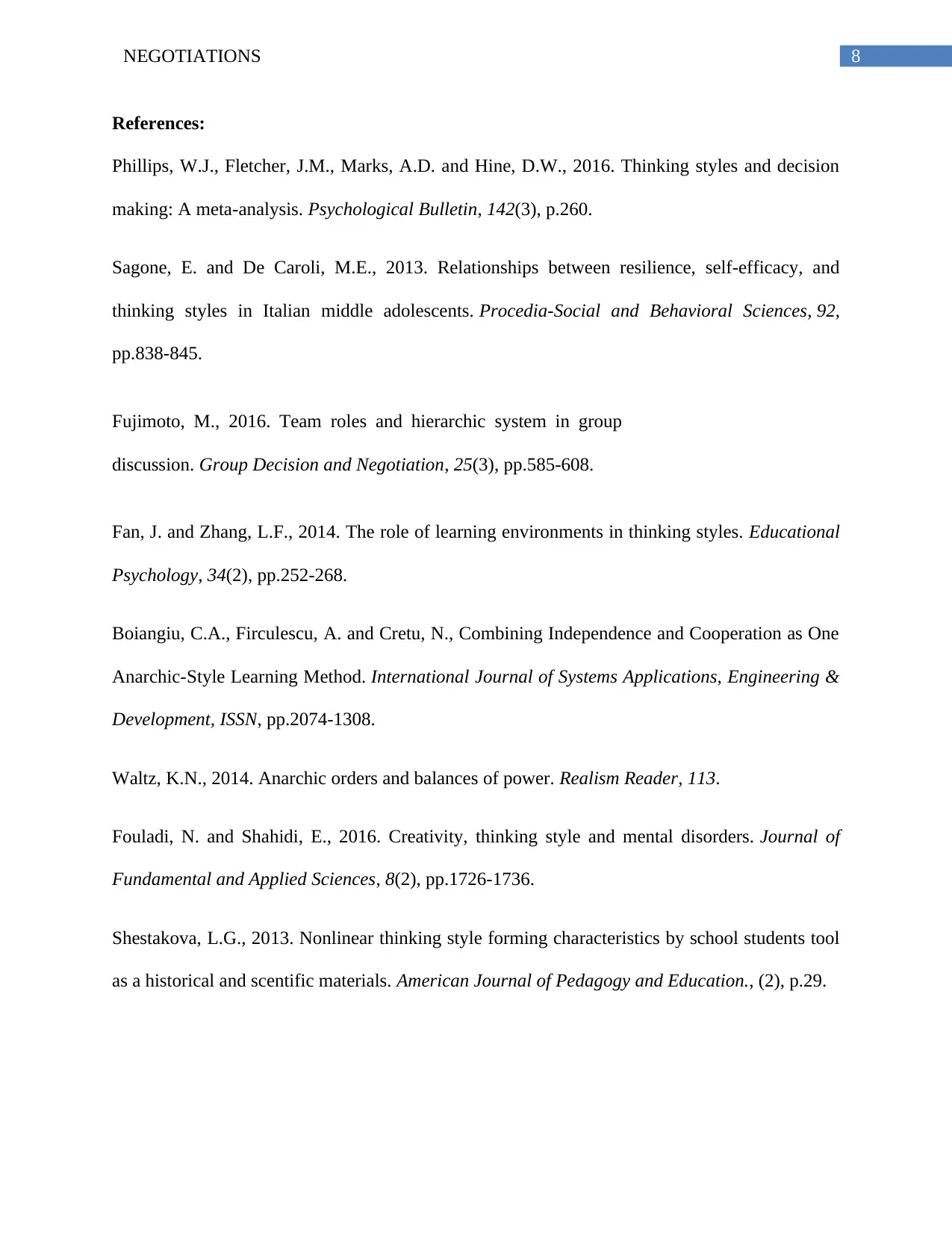
8NEGOTIATIONS
References:
Phillips, W.J., Fletcher, J.M., Marks, A.D. and Hine, D.W., 2016. Thinking styles and decision
making: A meta-analysis. Psychological Bulletin, 142(3), p.260.
Sagone, E. and De Caroli, M.E., 2013. Relationships between resilience, self-efficacy, and
thinking styles in Italian middle adolescents. Procedia-Social and Behavioral Sciences, 92,
pp.838-845.
Fujimoto, M., 2016. Team roles and hierarchic system in group
discussion. Group Decision and Negotiation, 25(3), pp.585-608.
Fan, J. and Zhang, L.F., 2014. The role of learning environments in thinking styles. Educational
Psychology, 34(2), pp.252-268.
Boiangiu, C.A., Firculescu, A. and Cretu, N., Combining Independence and Cooperation as One
Anarchic-Style Learning Method. International Journal of Systems Applications, Engineering &
Development, ISSN, pp.2074-1308.
Waltz, K.N., 2014. Anarchic orders and balances of power. Realism Reader, 113.
Fouladi, N. and Shahidi, E., 2016. Creativity, thinking style and mental disorders. Journal of
Fundamental and Applied Sciences, 8(2), pp.1726-1736.
Shestakova, L.G., 2013. Nonlinear thinking style forming characteristics by school students tool
as a historical and scentific materials. American Journal of Pedagogy and Education., (2), p.29.
References:
Phillips, W.J., Fletcher, J.M., Marks, A.D. and Hine, D.W., 2016. Thinking styles and decision
making: A meta-analysis. Psychological Bulletin, 142(3), p.260.
Sagone, E. and De Caroli, M.E., 2013. Relationships between resilience, self-efficacy, and
thinking styles in Italian middle adolescents. Procedia-Social and Behavioral Sciences, 92,
pp.838-845.
Fujimoto, M., 2016. Team roles and hierarchic system in group
discussion. Group Decision and Negotiation, 25(3), pp.585-608.
Fan, J. and Zhang, L.F., 2014. The role of learning environments in thinking styles. Educational
Psychology, 34(2), pp.252-268.
Boiangiu, C.A., Firculescu, A. and Cretu, N., Combining Independence and Cooperation as One
Anarchic-Style Learning Method. International Journal of Systems Applications, Engineering &
Development, ISSN, pp.2074-1308.
Waltz, K.N., 2014. Anarchic orders and balances of power. Realism Reader, 113.
Fouladi, N. and Shahidi, E., 2016. Creativity, thinking style and mental disorders. Journal of
Fundamental and Applied Sciences, 8(2), pp.1726-1736.
Shestakova, L.G., 2013. Nonlinear thinking style forming characteristics by school students tool
as a historical and scentific materials. American Journal of Pedagogy and Education., (2), p.29.
⊘ This is a preview!⊘
Do you want full access?
Subscribe today to unlock all pages.

Trusted by 1+ million students worldwide

9NEGOTIATIONS
Mason, M.F., Lee, A.J., Wiley, E.A. and Ames, D.R., 2013. Precise offers are potent anchors:
Conciliatory counteroffers and attributions of knowledge in negotiations. Journal of
Experimental Social Psychology, 49(4), pp.759-763.
Mason, M.F., Lee, A.J., Wiley, E.A. and Ames, D.R., 2013. Precise offers are potent anchors:
Conciliatory counteroffers and attributions of knowledge in negotiations. Journal of
Experimental Social Psychology, 49(4), pp.759-763.
1 out of 10
Related Documents
Your All-in-One AI-Powered Toolkit for Academic Success.
+13062052269
info@desklib.com
Available 24*7 on WhatsApp / Email
![[object Object]](/_next/static/media/star-bottom.7253800d.svg)
Unlock your academic potential
Copyright © 2020–2025 A2Z Services. All Rights Reserved. Developed and managed by ZUCOL.





